Lily Of The Valley (Convallaria Majalis): Meaning, Symbolism, Poisonous, Care Guide
While it’s true that lily of the valley is renowned for its potent fragrance, this perennial plant is also prized for its elegant white blooms and low-maintenance care. Despite being toxic, you can still find it featured in floral arrangements and container gardens. If you’re considering growing your own lily of the valley, here’s a comprehensive guide to get you started.
The plant has several variations, including Convallaria majalis ‘Albostriata’, ‘Rosea’, ‘Fortin’s Giant’, ‘Prolificans’ (double), ‘Flore Pleno’, and ‘Hardwick Hall’. When it comes to colors, lily of the valley typically produces white blooms.
When planting, consider the right time, location, and technique. The plant requires specific soil, fertilizer, sunlight, water, humidity, and temperature conditions for optimal growth.
It’s also important to know how to repot, prune, propagate, and care for lily of the valley in winter and indoors.
Furthermore, be aware of potential diseases and pests that can affect your plants, as well as its toxicity and how to safely remove it if needed.
Lily of the valley facts
Despite being familiar with the lily of the valley, there’s more to this charming plant than meets the eye. For instance, did you know that its botanical name is Convallaria majalis and that it shares a unique characteristic with asparagus due to its rhizomatic arrangement and stolon growth? This plant has a rich history, being native to Eurasia and North America, where it’s also known by various names such as May lily, Our Lady’s tears, May bells, and Mary’s tears.
Its significance is further emphasized by the fact that it was Kate Middleton’s bridal bouquet when she married Prince William. Moreover, the lily of the valley holds special cultural importance, being the national flower of Finland and the official floral emblem of Yugoslavia. In a surprising twist, this seemingly delicate flower is actually referenced more than any other except for the rose and lily in the Bible.
However, its beauty is tempered by its toxicity, making it unappealing to most critters.
Lily of the Valley flower meaning & symbolism
The lily of the valley has a rich symbolic history that spans over a thousand years across various cultures and religions. In Christian tradition, this flower is deeply rooted in biblical references, often symbolizing innocence, purity, and redemption. The plant’s association with Mary’s tears during Christ’s crucifixion further solidifies its significance as a symbol of devotion and fidelity.
Additionally, the lily of the valley has been linked to Eve’s trail of tears after her banishment from Eden, underscoring its connection to themes of innocence and sorrow. Beyond these spiritual connotations, the flower is also deeply ingrained in European wedding traditions, often featuring prominently in bouquets. As the official birth month flower for May, it is also known as the May flower, embodying the virtues of purity, humility, and new beginnings.
Types of Lily of the Valley
Convallaria majalis ‘Albostriata’
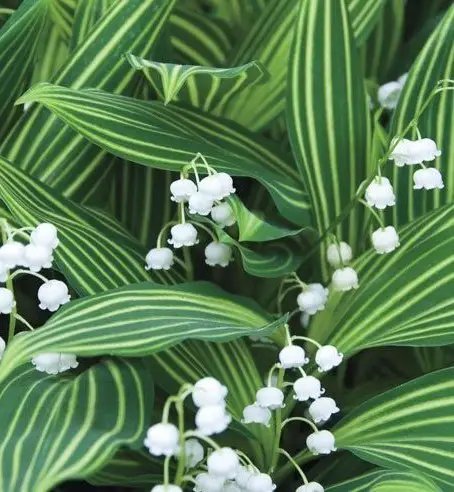
What sets this particular variety apart is its striking foliage, featuring dark green leaves with vibrant yellow and white stripes that seem to point upwards. One of the most significant advantages of this type is its compact growth habit, which means it won’t spread too far and wide, making it an excellent choice for creating a beautiful garden bed or container display.
Convallaria majalis ‘Rosea’
While its name may evoke images of lush, white blooms, the ‘Source’ variety of lily of the valley defies expectations with its pink, rose-like flowers. What’s more, this unique cultivar produces a mere handful of blooms per stalk, a far cry from the abundance typical of traditional lilies. Moreover, its fragrance is less pronounced than that of its white counterpart, making it an intriguing departure from the norm.
Convallaria majalis ‘Fortin’s Giant’
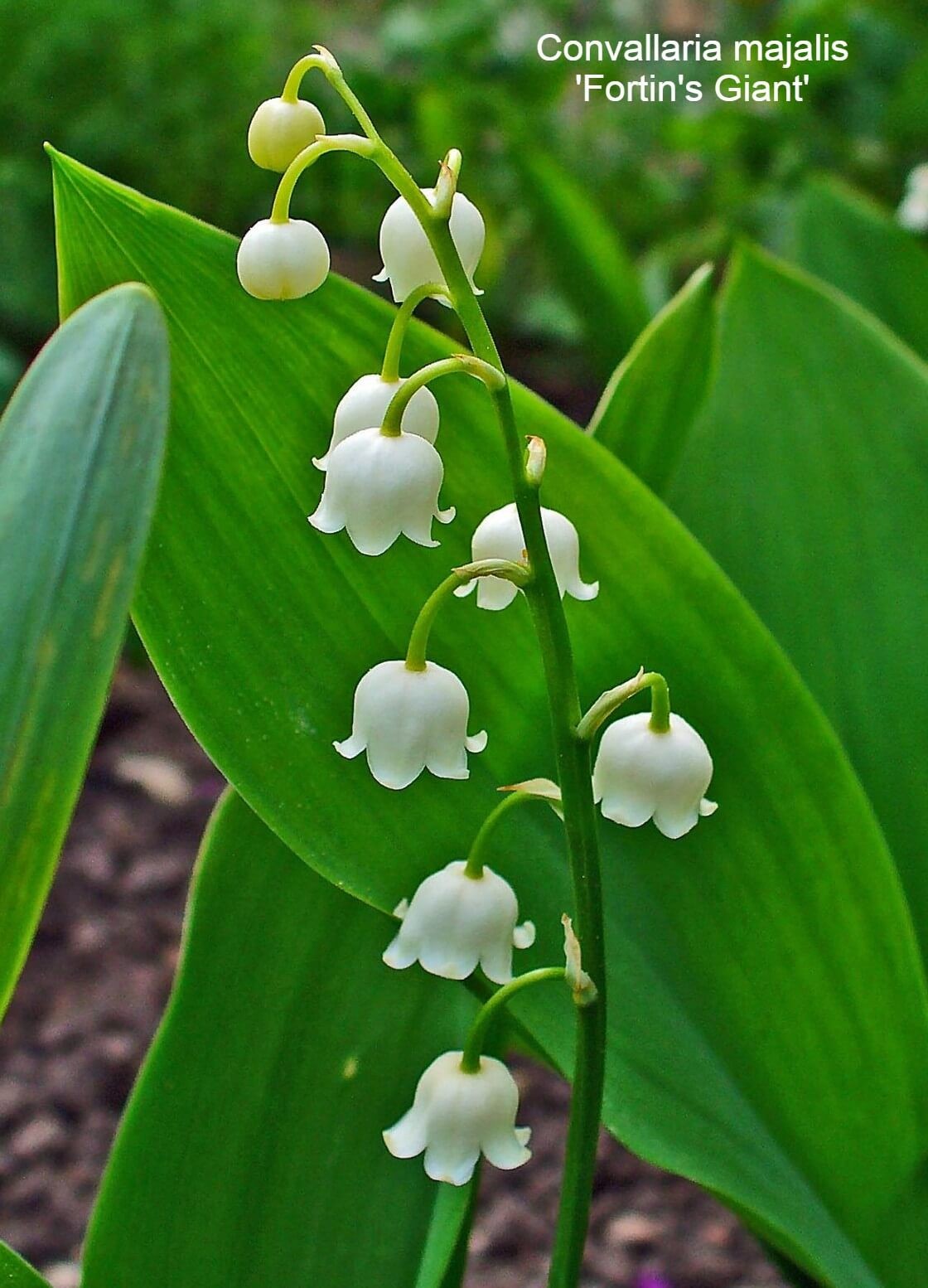
The prized ground cover variant of lily of the valley stands out due to its substantial, dark green foliage. Unlike other cultivars, this one is specifically suited to shaded areas. In addition to its role in erosion control, the plant’s stunning white flowers with a sweet fragrance are often cut for use in wedding bouquets, adding an extra touch of elegance to these special occasions.
Convallaria majalis ‘Prolificans’ (Double lily of the valley)

One of the most striking features of this unusual lily of the valley variety is its double blooms, which are far less common than those found on traditional lilies. While the flowers may not be as densely clustered, they have the added advantage of lasting longer when used in floral arrangements. In fact, cut stems from this rare variety can thrive in a vase for over a week, compared to the typical three-day lifespan of more conventional lily of the valley blooms.
Convallaria majalis ‘Flore Pleno’
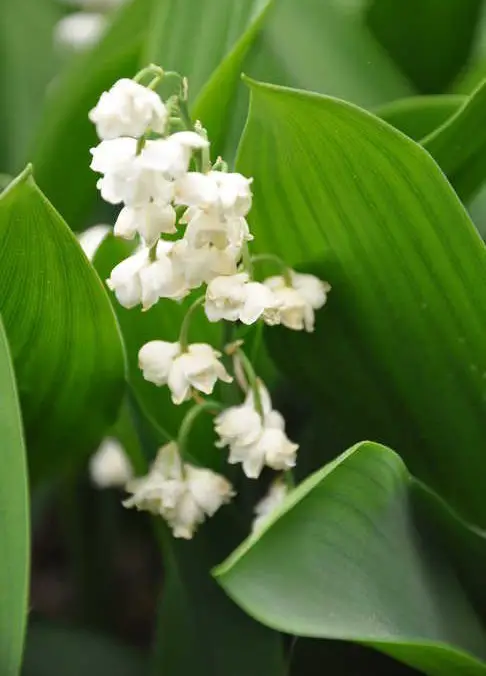
This variety, similar to the Fortin’s, exhibits a unique affinity for shade. Its most notable feature is its fragrant double-flowered blooms that emerge during spring, attracting pollinators such as bees and butterflies. Additionally, it boasts striking long, lancing, and pendant-shaped leaves with dark green hues that add to its overall appeal.
Convallaria majalis ‘Hardwick Hall’
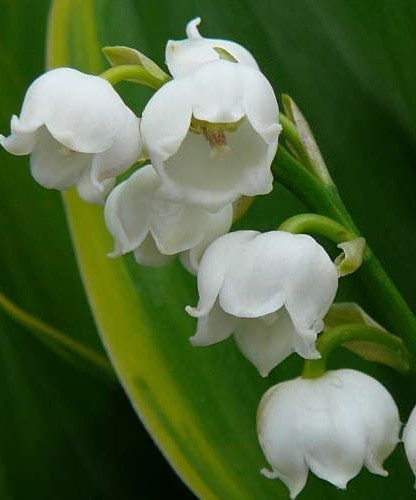
While sharing similarities with the Albostriata, this variant boasts a distinct paler green hue. One notable difference is its larger blooms, which set it apart from the typical lily of the valley. Its flexibility also makes it an attractive option for a variety of uses. It can thrive as a border plant, add charm to a garden bed, or be pruned and trained as a shrub, making it a versatile addition to any landscape.
Lily of the valley colors
The lily of the valley’s color palette is relatively limited, with a focus on whites and subtle variations. The majority of its bell-shaped flowers are pure white, while some varieties feature creamy whites with hints of yellow. While pink tones do appear, ranging from pale to deeper hues, it’s worth noting that these colors are not as prominent in the overall spectrum. Meanwhile, the plant’s berries offer a more vibrant display, coming in shades of yellow and white, red, or even blue.
Planting Lily of the valley

When to plant
When it comes to planting lily of the valley, timing is everything. Specifically, the ideal moment is late fall, when the cooler temperatures signal the start of dormancy. This allows the plant’s rhizomatic roots – or pips as they’re often called – to settle in comfortably after flowering. As a result, November and December are the recommended planting periods. By doing so, you’ll be giving your lily of the valley the best possible chance to produce vibrant blooms come springtime.
Where to plant
While lilies of the valley can tolerate shade, they actually prefer partial shade to full sun. This makes them well-suited for planting under trees or shrubs, where they can receive indirect light. In these conditions, the plant will thrive and produce its fragrant white flowers. It’s worth noting that lilies of the valley are not typically grown indoors due to their toxicity, which makes them harmful if ingested by humans or animals.
However, you can still enjoy the beauty of the flowers by cutting and arranging them in a vase.
How to plant
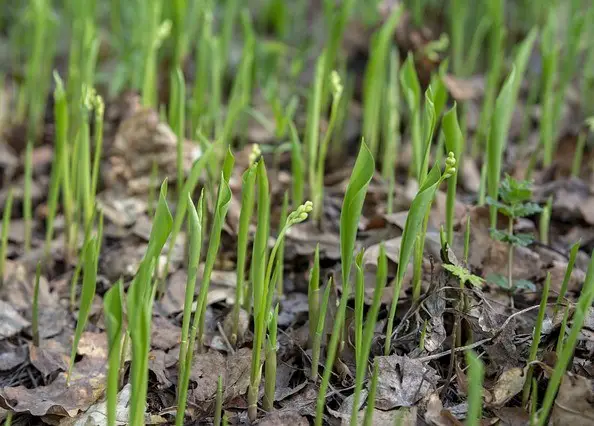
To initiate the process of planting lily of the valley, begin by cutting a sufficient quantity of root stocks. Submerge these roots in water for at least an hour before allowing them to dry completely. This crucial step ensures the roots are adequately hydrated and ready for further processing.
Following this initial step, separate the crowns while ensuring each one is accompanied by its own set of root stock and shoots.
This delicate task requires attention to detail, as the optimal outcome relies on maintaining the integrity of each crown. Once separated, plant the individual crowns in 8-inch pots filled with moist soil.
As the plants grow, it’s essential to cover them thoroughly with soil, leaving only the shoot visible above the surface. This controlled environment allows the roots to spread and establish themselves in preparation for eventual re-planting in a shaded outdoor location.
Lily of the valley care
Soil
Native to woodlands, this plant thrives in environments with moist, well-draining soils that have a moderately acidic pH of 6-6.5, reminiscent of forest floors. It can tolerate both sandy and loamy soil types. However, caution is advised against overwatering, as this can lead to soggy soil conditions conducive to root rot.
Fertilizer
Unlike many moisture-loving plants, the lily of the valley exhibits a unique preference when it comes to fertilization. Rather than requiring heavy doses of nutrients, this species thrives with a more subtle approach. In fact, over-fertilization can be detrimental to its growth. A simple and effective way to nourish your lily of the valley is to add a thin layer of organic compost or 2-3 inches of mulch annually, allowing it to thrive without excessive nutrient input.
Sun & Light
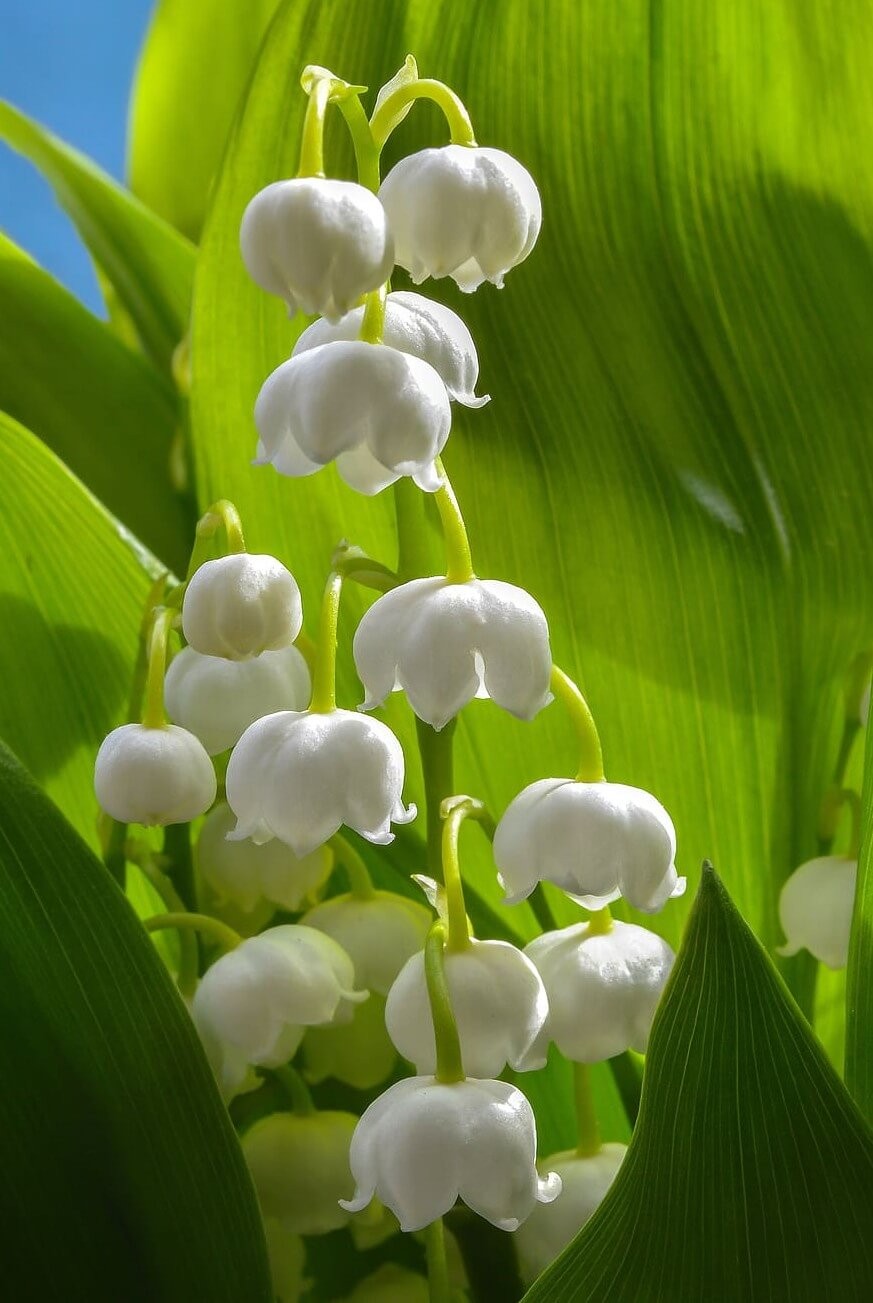
When it comes to providing optimal conditions for this plant, shade takes precedence over direct sunlight. In fact, it’s best suited for environments with partial shade, especially during peak hours (10am onwards). Even short periods of intense sunlight can be detrimental if not mitigated by relocating the plant to a shadier area. Additionally, if your plant is consistently exposed to excessive sun, it may require more frequent watering to prevent stress and damage.
Furthermore, planting this species in extremely sunny climates will result in poor performance, as it will struggle to bloom and its leaves will wither and turn yellow, ultimately leading to their demise.
Water requirements
When it comes to hydrating your plants, a consistent yet measured approach is key. As with many moisture-loving species, it’s best to water them daily, but be mindful of the amount you’re providing. Allow at least two inches of topsoil to dry out before replenishing the water supply. To further regulate the environment and maintain optimal moisture levels, consider implementing a morning misting routine focused on the leaves and base of the plant.
During the growing season, which typically spans from spring to early summer, it’s essential to deliver thorough watering sessions to support healthy development.
Humidity and temperature
Lily of the valley thrives in cooler climates, tolerating temperatures as low as -11°C in USDA zones 2-9. It flourishes in environments with low humidity, making it an ideal choice for rooms with a cool and dry atmosphere. However, during the summer months and periods of drought-like humidity, this lovely plant requires careful attention. To keep it happy and healthy, it’s essential to relocate it to a shaded area and ensure consistent watering to maintain its preferred moisture levels.
Repotting
When root overgrowth occurs, carefully excavate the rootstock to replant the lily of the valley. By repeating the original planting process, you’ll be able to overcome this obstacle and ensure a healthy start for your new growth.
Pruning
When it comes to maintaining your plant’s appearance, simply remove any yellow or brown leaves as needed. However, this type of plant requires a different approach when it comes to pruning and dividing. Instead of regular trimming, it’s essential to divide the stolon or root stock on a regular basis. This process can be carried out during the first frost of autumn or early spring, allowing you to remove any unwanted stolons and keep your plant healthy and thriving.
Propagation
Lilies of the valley exhibit a unique ability to propagate themselves through their rhizomatic roots, which spread effortlessly into colonies. Additionally, they reproduce via berry-like seeds that can disperse freely. However, for those who want to take an active role in propagation, there are two effective methods. Firstly, one can plant pips in moist, well-draining soil during the summer months.
Secondly, planting multiple pips simultaneously allows for self-pollination and subsequent berry production.
How to care for lily of the valley in winter
While enthusiasts of winter’s chill may appreciate the season’s icy grip, many species will enter a state of dormancy around mid-winter. To ensure proper care during this period, it is crucial to carefully manage the remaining stalks once their blooms have faded. This involves pruning off any yellowed or wilted leaves, allowing the plant to recharge and emerge anew come winter’s end.
How to care for Lily of the valley indoors
While lilies of the valley can thrive outdoors during specific seasons, their toxicity renders them unsuitable for direct exposure. A solution lies in indoor cultivation from mid-fall to winter or summer, when temperatures soar and humidity is high. If you’re willing to dedicate space, keeping one potted allows for precise watering control, taking into account seasonal fluctuations. Be vigilant, nonetheless, as yellowing leaves may indicate overwatering, a common pitfall to avoid.
Lily of the valley diseases & pests
The lily of the valley, while a beautiful addition to any garden, harbors some surprising secrets. For instance, it’s toxic to humans and larger animals like rabbits, deer, dogs, cats, and horses. While other insects may be wary of its toxicity, certain pests do find it appealing, particularly during spring when its foliage is at its most vibrant. Spider mites, for example, are known to feed on the leaves during this time, causing them to become sappy and turn yellow.
Snails and slugs are also common culprits, not only stripping soil of nutrients but also producing unsightly leaf spots. In terms of diseases, lily of the valley is susceptible to fungal rotting or rusting if its leaves become too waterlogged, or Southern blight, which manifests as yellow or brown ball-like growths on stems, at the plant’s base, or around the soil.
To combat these issues, gardeners typically employ fungicides, remove yellow/dead leaves promptly, and adjust watering habits to prevent overwatering.
Toxicity of Lily of the Valley
While the lily of the valley’s symbolic beauty is undeniable, it’s essential to acknowledge the plant’s toxic properties. All its parts – including red berries and delicate white flowers – pose a risk to humans and animals. If you choose to cultivate this plant in your yard, it’s crucial to ensure that these features don’t attract the attention of children or pets.
The plant’s toxicity stems from cardiac glycosides, which are used in medicine to treat cardiovascular conditions like congestive heart failure. In fact, a single lily of the valley plant can contain over 40 different types of this compound, making ingestion without regulation potentially fatal. Adding to its toxicity is a rare amino acid that can trigger seizures and cardiac arrest if consumed. As such, thorough hand washing is recommended whenever you come into contact with the plant.
How to get rid of lily of the valley
Given its underground rhizome system, manual removal of lily of the valley can be a daunting task. For effective eradication, a glyphosate-based herbicide is required. When applying this solution, it’s essential to time your spray session during peak sun hours or when temperatures exceed 45 degrees Celsius. Be aware that immediate results are not guaranteed; instead, repeated applications over at least two weeks are necessary to achieve complete elimination.
Conclusion
While other plants may possess unique characteristics, the lily of the valley’s reputation stands unparalleled. Its versatility as a popular flower cut, widely recognized religious symbol, and exotic appearance make it a standout. Moreover, its ease of care belies its toxic properties, rendering it a true enigma in the plant kingdom. Should you decide to cultivate one, it is crucial to attend to its specific needs and remain cognizant of the insights presented herein.
Related Posts
When sending or receiving flower deliveries, it’s natural to wonder about the etiquette surrounding gratuities. Should you tip your floral courier? The answer lies in understanding the standard practices and expectations within the industry. With this guide, we’ll delve into the world of tipping for your floral courier, helping you navigate the complexities of giving a thoughtful nod to the people who bring joy and beauty to your doorstep.






